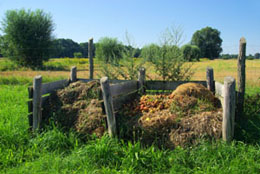By making a compost pile, you can have an easy access to an organic fertilizer that is rich in essential minerals and nutrients. It is not difficult to make a compost pile. So, find out how to make one in your backyard, in this Buzzle article.

Compost is a nutrient-rich material produced by the decomposition of organic waste, like food materials and dead plants. So, we can utilize our household garbage, and dead and decaying plant parts to make nutrient-rich compost for our garden plants.
Compost is an environment-friendly option as compared to chemical fertilizers. Some other advantages of using compost are, the better drainage of water in clay soil, water retention in sandy soil, and the growth of beneficial microorganisms in the soil.
Steps to Make a Compost Pile
The first step is to select a suitable place for composting. You will definitely find such a place in your backyard, which is convenient and also hidden from the sight of other people. Though you do not always need a bin or a container to make a compost pile, using one can help you confine it to a particular place, and thereby keep the surrounding area neat and clean.
A bin or container with a lid will also help protect your compost pile from flies and other insects. It is also the best option to protect the pile from heavy rain, and maintain the accurate level of moisture required for organic composting. You can either buy it or make a compost bin yourself by using spare pieces of plywood or wire. The bin should be large. Usually, a 3 ft tall, 3 ft wide, and 3 ft deep bin is ideal for this purpose. If you have decided to use a ready-made compost bin or container, then make some holes in the bin on the sides, as well as at the bottom, in order to facilitate proper ventilation.
Now, you have to mix two parts of brown or carbon-rich materials, to one part of green or nutrient-rich materials, in order to make compost. Examples of brown materials are dead or dry leaves and other plant parts, garden debris, wood ash, wood chips, etc. On the other hand, fresh vegetable wastes, fruit scraps, fresh grass, leaves and other fresh plant parts are the examples of green materials. The green materials are very rich in nutrients, especially in nitrogen.
To ensure rapid decomposition of all these materials, break them into smaller parts. Then add some garden soil to start the process of organic decomposition. Finally, add some water to the pile to make it moist, as moisture is also essential for decomposition. It is advisable to add water occasionally to the compost pile to maintain an appropriate level of moisture.
Compost Pile Maintenance
A compost pile is not very difficult to maintain. Just make sure to add dry leaves and kitchen waste occasionally. Also, stir the materials with the help of a tool at least once in a week. If the smell coming from the pile is too strong, it indicates an excessive level of moisture. In such a situation, stop adding water. Instead of water, add some more brown materials into the pile. Applying ammonia can also help eliminate the smell. Never dump meat, oil, dairy products, and weeds and plants on which pesticides or herbicides have been applied, to your compost pile.
It usually takes a period of three months to a year to complete the process of decomposition. When you cannot identify the original materials, and the compost no longer heats up, you will know that your compost is ready. But before applying on the plants, make sure that all the waste materials have fully decomposed.






 Compost is a nutrient-rich material produced by the decomposition of organic waste, like food materials and dead plants. So, we can utilize our household garbage, and dead and decaying plant parts to make nutrient-rich compost for our garden plants.
Compost is a nutrient-rich material produced by the decomposition of organic waste, like food materials and dead plants. So, we can utilize our household garbage, and dead and decaying plant parts to make nutrient-rich compost for our garden plants.